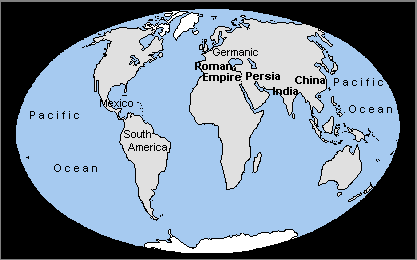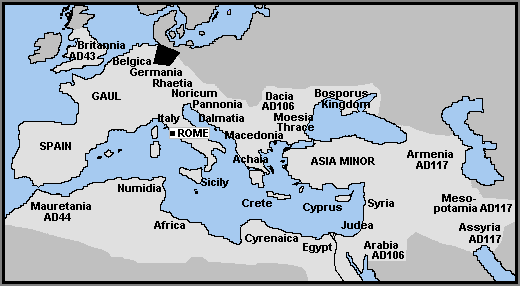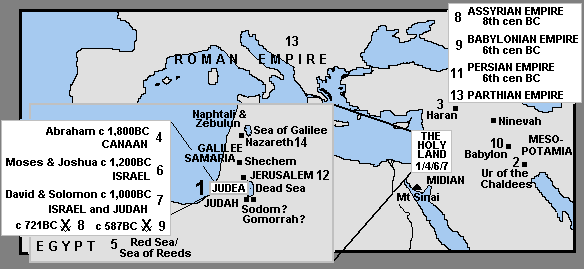1. THE WORLD BEYOND PALESTINE
Map - The World in Outline at the Time of Jess
Key:
Persia - major empires
Mexico - other centres of world population
Other worlds and civilisations lay beyond the Palestine of Jesus and the Roman Empire of which it formed a small part. In the Americas, the Olmec peoples of Mexico had faded away and the Mayan culture was establishing itself. The Aztec, and in South America, the Inca civilisations lay centuries in the future. Much of the vast Pacific Ocean and its many islands were being colonised by the descendants of mainly South East Asian peoples. In Asia, large empires existed in China (the Han dynasty), India (the Kushan empire), and Persia (the Parthian empire). Much of central and eastern Europe was occupied by Germanic tribes.
The Hindu and later the Jain religions had long been practised in India, and Buddhism was starting to spread from there into China. The teachings of Confucius and Lao-tzu (Taoism) had developed over the previous five centuries in China. In Persia, Zoroastrianism was the principle religion.
2. THE ROMAN EMPIRE
Map - The Roman Empire at its Greatest Extent, c AD117
Key:
SPAIN, GAUL, ASIA MINOR - each area consisted of a number of Roman provinces
AD43 etc - territories captured by Rome after the Birth of Jesus
black area - part of Germania lost to Rome after the Battle of Teutoberg AD9
The Roman Empire which by the birth of Jesus controlled most present-day countries bordering the Mediterranean basin including North Africa, was still expanding. Territories remaining to be conquered before the Empire of Rome reached its greatest extent under Trajan (emperor AD98-117) included:
Mauretania - present day Morocco and parts of Algeria,
Britannia - Britain,
Dacia - Rumania and part of Hungary,
Armenia, Mesopotamia and Assyria - which includes present day Iraq,
Arabia - modern Jordan.
The works of Greek philosophers such as Socrates, Plato, and Aristotle were widely circulated, and the people of the Roman Empire worshipped a variety of gods. Mithraism - a version of Zoroastrianism - became widespread for a time.
3. A HISTORY OF PALESTINE
Map - Jewish History in Outline, c 1,800BC-AD
Key: 1. Sequence of events. Also in text in [red square brackets]
At the time of the Roman Empire,[1] Judea was a small eastern province. Approximately 1,800 years earlier, the patriarch Abraham journeyed there from[2] Ur of the Chaldees (present-day Iraq), via[3] Haran to[4] Canaan. Abraham was the father of Isaac, and grandfather of Jacob.
Jacob's children migrated to Egypt where their younger brother Joseph ("of the coat of many colours") previously sold by them into slavery, had become only second in importance to the Egyptian Pharaoh. Jacob's descendants became the twelve tribes of Israel.
Around 1,200BC, following the Exodus from[5] Egypt led by Moses and completed by Joshua (of the "battle of Jericho"), Canaan was the "promised land" of the twelve
[6] Tribes of Israel After c 1,000BC, by which time King David and his son Solomon had established a[7] United Kingdom of Israel and Judah both nations went their separate ways until conquered by other empires.
In c 721BC,[8] Israel was defeated by the Assyrians and these Jews went into permanent exile. Then in c 587BC,
[9] Judah fell into the hands of the Babylonians, but their exile to
[10] Babylon was temporary. The Babylonians were conquered by the[11] Persians and the Jews allowed to return to Judea to rebuild[12] Jerusalem.
By the time of Jesus, most Jews were spread throughout the
[13] Roman and Parthian Empires, but Jerusalem with a new Temple being built by Herod the Great remained central to the Jewish religion.
Jesus of
[14] Nazareth in Galilee was therefore born a Jew, into nearly 2,000 years of Jewish history, religion and culture in the land of Palestine.
4. THE TERRITORIES and RULERS OF PALESTINE
Palestine is a small but varied land, often harsh in character and with a long and complicated history. Understanding something of its physical and political geography helps to explain the volatile situation into which Jesus came and preached, and the terrain over which he travelled.
When Israel in the north ceased to exist in c 721BC, part of the area later became a territory known as Samaria. Most of Judah in the south, defeated in c 587BC, was later referred to as Judea. By the time of Jesus,PALESTINE comprised various territories. From north to south these were:
1. Chalcis and Abilene in the Roman province of Syria, north of ancient Iturea;
2. Iturea, including Panias and Ulatha, and Trachonitis with Batanaea, Gaulanitis (the modern Golan Heights) and Auranitis, all in south eastern Syria. Hereafter, they are referred to as Iturea and Trachonitis;
3. Galilee with the Sea of Galilee in modern northern Israel, which played an important part in the recorded life and ministry of Jesus;
4. Samaria, Judea and Idumea, that is much of modern central Israel plus the west bank of the River Jordan.
The chief city of the Roman rulers was Caesarea on the Mediterranean coast of Samaria. The Jewish capital was Jerusalem in Judea, where Jesus came a number of times, finally to be arrested, tried and crucified by the Jewish and Roman authorities.
5. The semi-independent Decapolis in modern northern Jordan, was a roughly defined area that included within its boundaries, most of the federated "Ten Cities" established by Alexander the Great.
One such city was Philadelphia - modern Amman, capital of Jordan. Other cities, one of which was Damascus, capital of modern Syria, were outside the boundaries;
6. Perea included much of the present east bank of the Jordan.
During New Testament times, these territories were ruled, at various dates in a variety of ways:
- Direct from Rome through Roman province administrators or governors known as procurators;
- Through the Roman governor of Syria, such as The Decapolis; and
- By Roman-appointed Jewish kings, ethnarchs or rulers, and tetrarchs or rulers of a fourth part of a province.



No comments:
Post a Comment